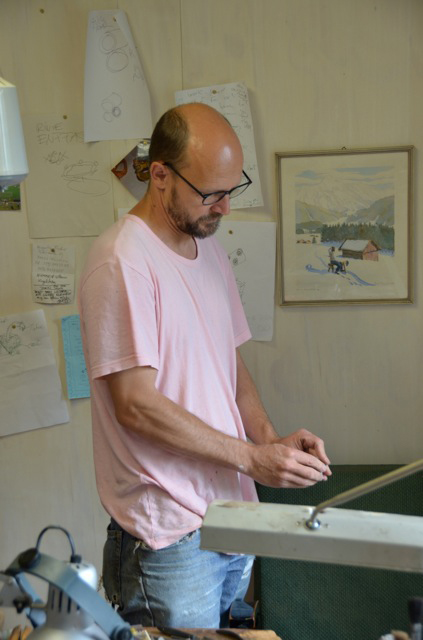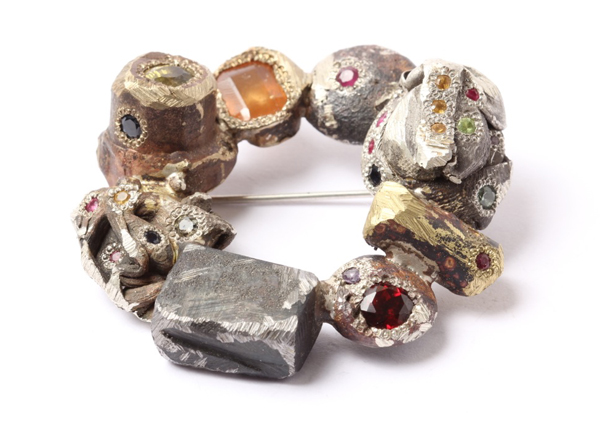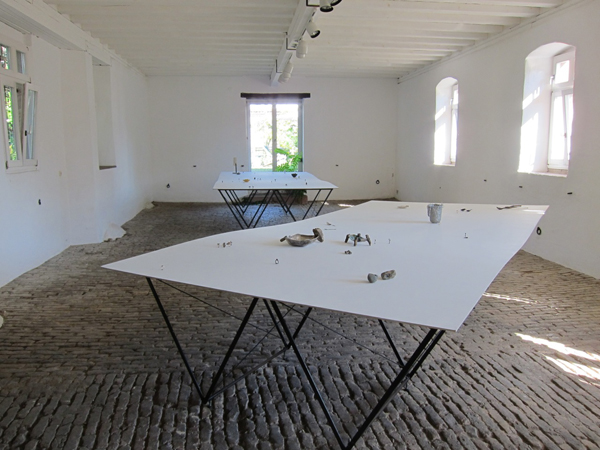
Susan Cummins: Gerd Rothmann wrote about the bowl you created for this show by saying: ‘Out of this bar of gold Karl Fritsch has wrought, using a heavy hammer in a somewhat disrespectful (if not brutal, or in any case quite unsubtle) way, a somewhat misshapen looking bowl. It would seem that he went about doing this with the express desire to shatter any professional notion of aesthetics: the manner in which he mistreated the precious and venerated material was admirably cheeky.’ Your approach is disquieting. Why do you work this way?
Karl Fritsch: If I answer that question I can tell you the story of my life, or I can say I don’t know. I think the text from Gerd gives a answer and it is my ultimate pleasure and reason to make work like that, if somebody can engage with it in the way Gerd does. No bullshit! The bit of text you quote is taken from a longer text. It might help to read the whole text as it gives some ideas about answers.
‘(First you have to imagine one kilogram of pure 24 carat gold: its weight; its golden yellow lustre; its softness. Merchants used to bite on gold coins, testing if the gold was genuine on the basis of the indentation made by their teeth.

When I saw the bowl for the first time and held it in my hands I recognised immediately that it has a strong archetypal force of expression: shifts and changes have always occurred in art when familiar paradigms are challenged and rules are provocatively broken.
This exceptional bowl found a buyer. The new owners did not place this valuable artwork in a safe but found a special place for it in their bedroom. He said that he would like to be able to take and hold the bowl every now and again and, besides, a thief wouldn’t identify this crudely malleated object as consisting of pure gold. She explained that the bowl contains a little mouse: this mouse is a present that he gave her 60 years ago, a souvenir from the early days when they first met.’

65 x 65 x 25 mm, photo: Karl Fritsch
I like working with metal. Like the golden bowl, it is a very basic research. It is goldsmithing. There is a piece of gold and a hammer and me, it cannot be any more basic and all three have their say.
You seem to be infatuated with rings since you make so many of them. Why rings?
I like the scale. Here is an interview and another statement about rings.
(Below Karl Fritsch interviews Karl Fritsch in September 2010)
‘KF: hmmm . . .
KF: There is always a reason to make a ring.
KF: But I can also make a ring without a reason.
KF: Aha, sounds a bit clever.
KF: I enjoy making, and I know that some rings have to be done very quickly. One moment, a ring wants to look a certain way, and the next, it wants to look like something quite different. Sometimes it even freaks out, is unruly, out of control. Sometimes a ring plays a joke on me, or it sits at the table like a good child, doing nothing. Then it’s about using the repertoire of skills, quickly soldering, casting, filing, setting stones. The ring can’t wait; it’s impatient and wants to hurry being ready for a finger.
KF: Is that right?

KF: I don’t like analysing my rings, but I’m happy if others do.
KF: I understand, it keeps you fresh.
KF: Yes.
KF: Of course the ring wants to be beautiful. The technique also wants to be beautiful, and most often it’s the idea that wants to be the most beautiful. But sometimes a ring likes nothing better than to sit in the mud and not give a damn about how it looks. If it’s exactly what it wants to be in a given moment, it is precise, perfect and the most beautiful.
KF: Well spoken.
KF: I’m always curious about the next ring.
KF: Me too.
KF: I’m always very happy when I accidentally meet somebody wearing one of my rings. Usually it looks different than when it left me, and this is great. It lives with somebody and experiences incredible things. The ring wants people to try it on – for whichever reason – and even a collector or a museum curator won’t be able to resist it. The ring is curious and looks for curious wearers.’
‘The ring is desperate, desperate to find a finger, desperate to tell you: I love you, I am beautiful, I am rich, I am cool, I hate you, I come from Ireland or Austria, I want more, I have enough, I am married, I am funny, I am scary, stupid, important, I can´t help you. I am.’
You studied with two of the legendary jewelry professors – Hermann Jünger and Otto Künzli at the Munich Academy. When you think of your education with them is there a story that particularly comes to mind?
Yes.

The whole title as printed on the invite actually is: ‘Lucy’ or scientifically: AL288-1. She was a female ape who lived in Africa 3.2 million years ago. After examination of bone formation in her hand, it was discovered she had the capability to hold tools between her thumb and forefinger. Lucy was named after a Beatles song Lucy In The Sky With Diamonds. Lucy – the first jeweler?
There have been three books published about your work: Karl Fritsch: Jewelry, Metrosideros Robusta and The Baby Brick. Did you participate in their development and publication? What is their significance?
I was certainly involved in the development but I was not involved in the design of the books. For me, they are great documentations of what I made and I enjoy looking at my jewelry through other’s eyes.
Thanks Karl





